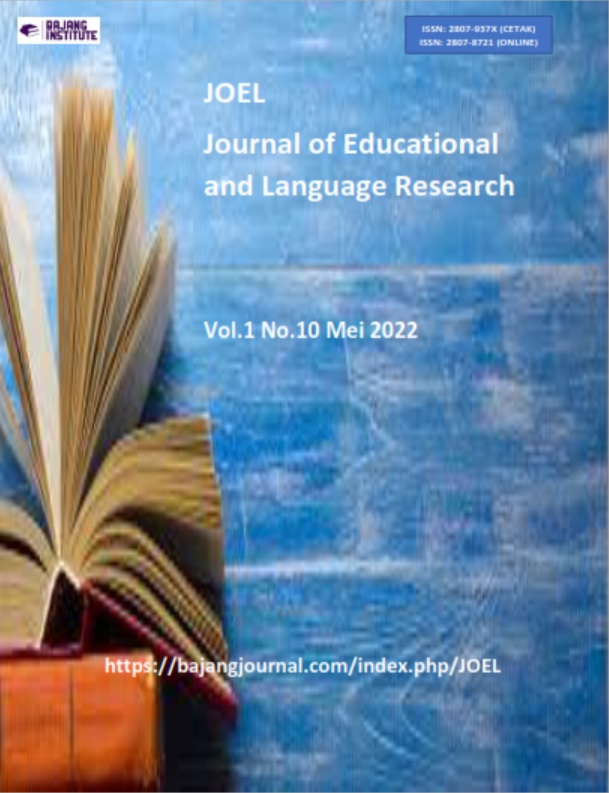MAKNA SIMBOLIK TRADISI BERBALAS PANTUN PADA PERKAWINAN ADAT MELAYU LANGKAT
DOI:
https://doi.org/10.53625/joel.v1i10.2292Keywords:
Meaning, Symbolic,, Reciprocating Pantun, Marriage, Malay Custom.Abstract
This study aims to describe the traditions at Malay weddings that are often said to be signaled, reluctant to be direct, but always say something by using parables and figuratively indirectly (using rhymes). The Symbolic Meaning of the Langkat Malay Traditional Marriage Procession (A Research on Symbols Containing Meaning at the Face-to-Face Rice Dinner in the Langkat Malay Traditional Wedding Ceremony Reception is a habit, in fact it almost becomes a custom. It is as if the Malays often tell people to think more deeply by using a few words to find their own interpretation. Pantun is part of the nature of Malay people's life, which of course can be used as learning. Even the rhyme itself is always associated with the vast nature. The philosophy of the Malays views nature as mirror of human life. They read nature to understand the existing situation as expressed in the proverb Alam Terbentang Become Guru, so that in the rhyme in the first line there are elements of nature and the next line is put forward the truth. One of the traditional ceremonies and traditions that are full of with the expression is a traditional Malay wedding ceremony This very important ceremony is full of symbols and meanings, both in the form of ceremonial fittings and the expressions used. In this ceremony, many parts are filled with expressions so that the ceremony makes this traditional ceremony feel more sacred, thick, dignified and solemn.
References
Arinda, Riza Sari. (2017). Komunikasi Simbolik Gerakan Tarian Dalam Proses Pelaksanaan Pernikahan Adat Karo di Kota Medan. Medan: Ilmu Komunikasi, Fakultas Ilmu Sosial dan Ilmu Politik, Universitas Sumatera Utara.
Effendy, Onong Uchjana. (2003). Ilmu, Teori dan Filsafat Komunikasi. Bandung: PT Citra Aditya Bakti.
Kaelan. (2005). Metode Penelitian Kualitatif Bidang Filsafat: Paradigma Bagi Pengembangan Penelitian Interdisipliner Bidang Filsafat, Budaya, Sosial, Semiotika, Sastra, Hukum dan Seni. Yogyakarta: Paradigma.
Koentjaraningrat. (2009). Pengantar Ilmu Antropologi. Jakarta: PT Rineka Cipta.
Liliweri, Alo. (2011). Komunikasi: Serba Ada Serba Makna. Jakarta: Kencana.
Miles, Matthew B dan A. Michael Huberman. (1992). Analisis Data Kualitatif. Jakarta: UI Press.
Moleong, Lexi J. (2006). Metode Penelitian Kualitatif, Edisi Revisi. Bandung: PT Remaja Rosdakarya.
Morissan. (2013). Teori Komunikasi: Individu Hingga Massa Edisi Pertama. Jakarta: Kencana.
Purwasito, Andrik. (2003). Komunikasi Multikultural. Surakarta: Muhammadiyah University Press.
Samovar, Larry A. (2010). Komunikasi Lintas Budaya (Edisi 7). Jakarta: Salemba Humanika.
Seto, Indiwan Wahyu Wibowo. (2011). Semiotika Komunikasi: Aplikasi Praktis Bagi Penelitian Dan Skripsi Komunikasi. Jakarta: Mitra Wacana Media.
Sinar, Tengku Luckman. (2005). Adat Budaya Melayu: Jati Diri dan Kepribadian. Sumatera Utara: Forum Komunikasi Antar Lembaga Adat.
Sobur, Alex. (2004). Semiotika Komunikasi. Bandung: PT Remaja Rosdakarya.
Suparno, Paul. (1997). Filsafat Konstruktivisme Dalam Pendidikan. Yogyakarta: Kanisius.
West, Richard dan Lynn H.Turner. (2008). Pengantar Teori Komunikasi: Analisis dan Aplikasi, Edisi 3, Buku 2. Jakarta: Salemba Humanika.











